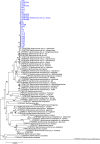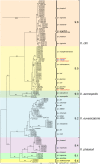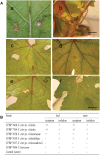Xanthomonas citri pv. viticola Affecting Grapevine in Brazil: Emergence of a Successful Monomorphic Pathogen
- PMID: 31057588
- PMCID: PMC6482255
- DOI: 10.3389/fpls.2019.00489
Xanthomonas citri pv. viticola Affecting Grapevine in Brazil: Emergence of a Successful Monomorphic Pathogen
Abstract
The pathovar viticola of Xanthomonas citri causes bacterial canker of grapevine. This disease was first recorded in India in 1972, and later in Brazil in 1998, where its distribution is currently restricted to the northeastern region. A multilocus sequence analysis (MLSA) based on seven housekeeping genes and a multilocus variable number of tandem repeat analysis (MLVA) with eight loci were performed in order to assess the genetic relatedness among strains from India and Brazil. Strains isolated in India from three related pathovars affecting Vitaceae species and pathogenic strains isolated from Amaranthus sp. found in bacterial canker-infected vineyards in Brazil were also included. MLSA revealed lack of diversity in all seven genes and grouped grapevine and Amaranthus strains in a monophyletic group in X. citri. The VNTR (variable number of tandem repeat) typing scheme conducted on 107 strains detected 101 haplotypes. The total number of alleles per locus ranged from 5 to 12. A minimum spanning tree (MST) showed that Brazilian strains were clearly separated from Indian strains, which showed unique alleles at three loci. The two strains isolated from symptomatic Amaranthus sp. presented unique alleles at two loci. STRUCTURE analyses revealed three groups congruent with MST and a fourth group with strains from India and Brazil. Admixture among populations were observed in all groups. MST, STRUCTURE and e-BURST analyses showed that the strains collected in 1998 belong to two distinct groups, with predicted founder genotypes from two different vineyards in the same region. This suggest that one introduction of grape planting materials contaminated with genetically distinct strains took place, which was followed by pathogen adaptation. Genome sequencing of one Brazilian strain confirmed typical attributes of pathogenic xanthomonads and allowed the design of a complementary VNTR typing scheme dedicated to X. citri pv. viticola that will allow further epidemiological survey of this genetically monomorphic pathovar.
Keywords: MLSA; MLVA; Vitis vinifera; Xanthomonas campestris pv. viticola; grapevine bacterial canker.
Figures






Similar articles
-
Taxonomic Repositioning of Xanthomonas campestris pv. viticola (Nayudu 1972) Dye 1978 as Xanthomonas citri pv. viticola (Nayudu 1972) Dye 1978 comb. nov. and Emendation of the Description of Xanthomonas citri pv. anacardii to Include Pigmented Isolates Pathogenic to Cashew Plant.Phytopathology. 2018 Oct;108(10):1143-1153. doi: 10.1094/PHYTO-02-18-0037-R. Epub 2018 Aug 20. Phytopathology. 2018. PMID: 29688131
-
Core-Genome Multilocus Sequence Typing for Epidemiological and Evolutionary Analyses of Phytopathogenic Xanthomonas citri.Appl Environ Microbiol. 2023 May 31;89(5):e0210122. doi: 10.1128/aem.02101-22. Epub 2023 Apr 17. Appl Environ Microbiol. 2023. PMID: 37067413 Free PMC article.
-
Polyphasic characterization of xanthomonads pathogenic to members of the Anacardiaceae and their relatedness to species of Xanthomonas.Int J Syst Evol Microbiol. 2009 Feb;59(Pt 2):306-18. doi: 10.1099/ijs.0.65453-0. Int J Syst Evol Microbiol. 2009. PMID: 19196770
-
Reclassification of Xanthomonas campestris pv. citri (ex Hasse 1915) Dye 1978 forms A, B/C/D, and E as X. smithii subsp. citri (ex Hasse) sp. nov. nom. rev. comb. nov., X. fuscans subsp. aurantifolii (ex Gabriel 1989) sp. nov. nom. rev. comb. nov., and X. alfalfae subsp. citrumelo (ex Riker and Jones) Gabriel et al., 1989 sp. nov. nom. rev. comb. nov.; X. campestris pv malvacearum (ex smith 1901) Dye 1978 as X. smithii subsp. smithii nov. comb. nov. nom. nov.; X. campestris pv. alfalfae (ex Riker and Jones, 1935) dye 1978 as X. alfalfae subsp. alfalfae (ex Riker et al., 1935) sp. nov. nom. rev.; and "var. fuscans" of X. campestris pv. phaseoli (ex Smith, 1987) Dye 1978 as X. fuscans subsp. fuscans sp. nov.Syst Appl Microbiol. 2005 Aug;28(6):494-518. doi: 10.1016/j.syapm.2005.03.017. Syst Appl Microbiol. 2005. PMID: 16104350
-
A MLVA genotyping scheme for global surveillance of the citrus pathogen Xanthomonas citri pv. citri suggests a worldwide geographical expansion of a single genetic lineage.PLoS One. 2014 Jun 4;9(6):e98129. doi: 10.1371/journal.pone.0098129. eCollection 2014. PLoS One. 2014. PMID: 24897119 Free PMC article.
Cited by
-
Contrasting genetic diversity and structure among Malagasy Ralstonia pseudosolanacearum phylotype I populations inferred from an optimized Multilocus Variable Number of Tandem Repeat Analysis scheme.PLoS One. 2020 Dec 8;15(12):e0242846. doi: 10.1371/journal.pone.0242846. eCollection 2020. PLoS One. 2020. PMID: 33290390 Free PMC article.
-
Suspicions of two bridgehead invasions of Xylella fastidiosa subsp. multiplex in France.Commun Biol. 2023 Jan 27;6(1):103. doi: 10.1038/s42003-023-04499-6. Commun Biol. 2023. PMID: 36707697 Free PMC article.
-
Trends in Molecular Diagnosis and Diversity Studies for Phytosanitary Regulated Xanthomonas.Microorganisms. 2021 Apr 16;9(4):862. doi: 10.3390/microorganisms9040862. Microorganisms. 2021. PMID: 33923763 Free PMC article. Review.
-
Molecular Epidemiology of Xanthomonas euvesicatoria Strains from the Balkan Peninsula Revealed by a New Multiple-Locus Variable-Number Tandem-Repeat Analysis Scheme.Microorganisms. 2021 Mar 5;9(3):536. doi: 10.3390/microorganisms9030536. Microorganisms. 2021. PMID: 33807692 Free PMC article.
-
Risk assessment of Xanthomonas citri pv. viticola for the EU.EFSA J. 2022 Dec 2;20(12):e07641. doi: 10.2903/j.efsa.2022.7641. eCollection 2022 Dec. EFSA J. 2022. PMID: 36474480 Free PMC article.
References
-
- Ah-You N., Gagnevin L., Grimont P. A. D., Brisse S., Nesme X., Chiroleu F., et al. (2009). Polyphasic characterization of xenthomonads pathogenic to members of the Anacardiaceae and their relatedness to species of Xanthomonas. Int. J. Syst. Evol. Microbiol. 59 306–318. 10.1099/ijs.0.65453-0 - DOI - PubMed
-
- Alegria M. C., Souza D. P., Andrade M. O., Docena C., Khater L., Ramos C. H. I., et al. (2005). Identification of new protein-protein interactions involving the products of the chromosome- and plasmid-encoded type IV secretion loci of the phytopathogen Xanthomonas axonopodis pv. citri. J. Bacteriol. 187 72315–72325. 10.1128/JB.187.7.2315-2325.2005 - DOI - PMC - PubMed
-
- Arrieta-Ortiz M. L., Rodriguez-R L. M., Pérez-Quintero A. L., Poulin L., Díaz A. C., Rojas N. A., et al. (2013). Genomic survey of pathogenicity determinants and VNTR markers in the cassava bacterial pathogen Xanthomonas axonopodis pv. manihotis strain CIO151. PLoS One 8:e79704. 10.1371/journal.pone.0079704 - DOI - PMC - PubMed
LinkOut - more resources
Full Text Sources
Molecular Biology Databases

